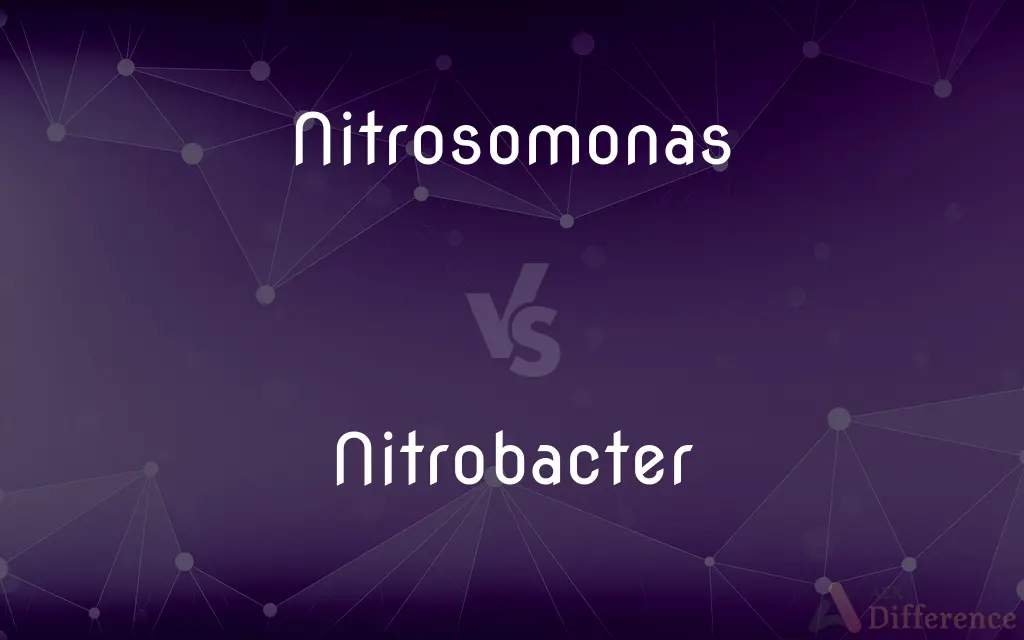Nitrosomonas vs. Nitrobacter — What's the Difference?
By Tayyaba Rehman — Updated on September 28, 2023
Nitrosomonas is a bacterium converting ammonia to nitrite in nitrogen cycle; Nitrobacter converts nitrite to nitrate, completing the nitrification process.

Difference Between Nitrosomonas and Nitrobacter
Table of Contents
ADVERTISEMENT
Key Differences
Nitrosomonas and Nitrobacter are both crucial bacteria involved in the nitrogen cycle, primarily contributing to the process of nitrification. Nitrosomonas specializes in converting ammonia (NH3) to nitrite (NO2-), initiating the nitrification process. This conversion is vital as ammonia is toxic to most organisms, and its conversion to nitrite mitigates its harmful impact on the environment.
On the other hand, Nitrobacter plays a subsequent role in nitrification by converting the nitrite (NO2-) produced by Nitrosomonas to nitrate (NO3-). This conversion is significant as nitrate is a primary nutrient used by plants. The ability of Nitrobacter to transform nitrite into a usable form of nitrogen allows for the sustenance and growth of plant life, contributing to ecological balance.
Nitrosomonas and Nitrobacter collectively facilitate the transformation of nitrogen compounds to forms assimilable by plants. Nitrosomonas’ role is pivotal as it detoxifies the environment by converting ammonia to nitrite, making it less harmful. Subsequently, Nitrobacter ensures the availability of essential nutrients for plant life by converting nitrite to nitrate, a form of nitrogen readily absorbed by plants.
While Nitrosomonas and Nitrobacter have distinct roles in the nitrogen cycle, their synchronized functioning is integral to maintaining ecological equilibrium. The specificity of each bacterium in converting particular compounds underscores the complexity and precision of biological processes within the nitrogen cycle. Together, Nitrosomonas and Nitrobacter optimize the availability of nitrogen compounds for the surrounding ecosystem, fostering biodiversity and ecological health.
Comparison Chart
Role in Nitrogen Cycle
Converts ammonia to nitrite.
Converts nitrite to nitrate.
ADVERTISEMENT
Importance
Detoxifies environment by reducing ammonia.
Provides plants with usable nitrogen form.
Process
Initiates nitrification process.
Completes the nitrification process.
Ecological Impact
Mitigates harmful impact of ammonia.
Contributes to ecological balance by providing essential nutrients to plants.
Interaction
Functions in synchronization with Nitrobacter.
Relies on Nitrosomonas for substrate availability.
Compare with Definitions
Nitrosomonas
A genus of bacteria involved in nitrogen cycling by converting ammonia to nitrite.
Nitrosomonas plays a crucial role in controlling ammonia levels in the environment.
Nitrobacter
Gram-negative bacteria contributing to the availability of essential nutrients for plant life.
Nitrobacter's activity in soil is vital for healthy ecosystems.
Nitrosomonas
Chemoautotrophic bacteria utilizing carbon dioxide as their sole carbon source.
Nitrosomonas thrives in environments where ammonia is present.
Nitrobacter
Bacteria responsible for oxidizing nitrite to nitrate in the nitrogen cycle.
Nitrobacter is essential for converting nitrite produced by Nitrosomonas to nitrate.
Nitrosomonas
A key component in wastewater treatment due to its ability to oxidize ammonia.
Efficient wastewater treatment relies on the activity of Nitrosomonas.
Nitrobacter
Aids in detoxifying environments by converting harmful nitrites to nitrates.
Nitrobacter is a critical component in mitigating nitrite toxicity in ecosystems.
Nitrosomonas
Gram-negative bacteria initiating the nitrification process in the nitrogen cycle.
The presence of Nitrosomonas in soil is essential for healthy plant growth.
Nitrobacter
Synchronizes with Nitrosomonas for optimum nitrogen availability in ecosystems.
The interaction between Nitrobacter and Nitrosomonas is crucial for ecological balance.
Nitrosomonas
Operates in the first step of nitrification, forming nitrite from ammonia.
Nitrosomonas is fundamental for the ecological nitrogen balance.
Nitrobacter
Plays a crucial role in completing the nitrification process by transforming nitrite to nitrate.
The presence of Nitrobacter in soil facilitates plant nutrient absorption.
Nitrosomonas
Nitrosomonas is a genus of Gram-negative bacteria, belonging to the Betaproteobacteria. It is one of the five genera of ammonia-oxidizing bacteria and, as an obligate chemolithoautotroph, uses ammonia as an energy source and CO 2 {\displaystyle {\ce {CO2}}} as a carbon source in presence of oxygen.
Nitrobacter
Nitrobacter is a genus comprising rod-shaped, gram-negative, and chemoautotrophic bacteria. The name Nitrobacter derives from the Latin neuter gender noun nitrum, nitri, alkalis; the Ancient Greek noun βακτηρία, βακτηρίᾱς, rod.
Nitrosomonas
Ellipsoidal soil bacteria
Nitrobacter
Any bacterium of the genus Nitrobacter.
Nitrobacter
A genus of rod-shaped soil bacteria.
Nitrobacter
Rod-shaped soil bacteria
Common Curiosities
What does Nitrobacter convert nitrite to?
Nitrobacter converts nitrite to nitrate, completing the nitrification process.
Is Nitrosomonas involved in converting ammonia to nitrite?
Yes, Nitrosomonas converts ammonia to nitrite in the nitrogen cycle.
Are Nitrosomonas and Nitrobacter gram-negative bacteria?
Yes, both Nitrosomonas and Nitrobacter are classified as gram-negative bacteria.
Are Nitrosomonas and Nitrobacter found in soil?
Yes, both are found in soil and play crucial roles in the nitrogen cycle.
Do Nitrosomonas and Nitrobacter work together in the nitrogen cycle?
Yes, their synchronized activity is crucial in maintaining nitrogen balance in ecosystems.
Is Nitrosomonas a chemoautotrophic bacterium?
Yes, Nitrosomonas is chemoautotrophic, utilizing carbon dioxide as its sole carbon source.
Is Nitrobacter vital for the detoxification of nitrite in environments?
Yes, Nitrobacter is essential for converting toxic nitrites to safer nitrates.
Are both Nitrosomonas and Nitrobacter important for plant growth?
Absolutely, they facilitate the conversion of nitrogen to forms that plants can absorb.
Is Nitrosomonas important for controlling ammonia levels in ecosystems?
Absolutely, it plays a critical role in mitigating the harmful impact of ammonia.
Does Nitrobacter contribute to plant nutrient absorption?
Yes, by converting nitrite to nitrate, it aids in making nitrogen available to plants.
Can Nitrosomonas and Nitrobacter be used in wastewater treatment?
Indeed, their ability to transform ammonia and nitrite makes them valuable in wastewater treatment.
Are Nitrosomonas and Nitrobacter beneficial to human activities?
Yes, their roles in nitrogen cycling and wastewater treatment are highly beneficial to human activities.
Can Nitrobacter function efficiently without Nitrosomonas?
Nitrobacter relies on Nitrosomonas for substrate availability, so their interaction is crucial.
Are Nitrosomonas and Nitrobacter found in environments where ammonia is present?
Yes, they are typically found in environments where ammonia is present, such as soil and water.
Do Nitrosomonas and Nitrobacter impact ecological balance?
Yes, they play a pivotal role in nitrogen cycling, influencing ecological balance and biodiversity.
Share Your Discovery

Previous Comparison
Weasel vs. Otter
Next Comparison
Complete vs. AccomplishAuthor Spotlight
Written by
Tayyaba RehmanTayyaba Rehman is a distinguished writer, currently serving as a primary contributor to askdifference.com. As a researcher in semantics and etymology, Tayyaba's passion for the complexity of languages and their distinctions has found a perfect home on the platform. Tayyaba delves into the intricacies of language, distinguishing between commonly confused words and phrases, thereby providing clarity for readers worldwide.
















































